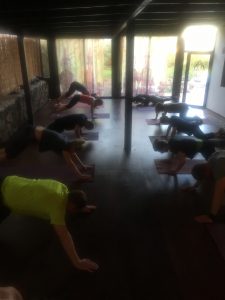Exercise Recovery: When is too much not too much?
Exercise Recovery: When is too much not too much?
We’re part-way through the second Fit for Life retreat and it’s going swimmingly. Great weather, great guests and a fantastic atmosphere. So far, the guests have done a LOT of exercise. Here’s a snapshot…
Monday: Circuits AM, Surfing 11-3, Pilates PM.
Today: Plyometrics AM, Weight Training PM.That’s so far. The rest of the week is as follows…
Thursday: Yoga AM, 4 hour Bike Ride and Volcano Hike 11-3, Meditation PM.
Friday: Circuits AM, Surfing 10-2, Yoga PM.
Saturday: Pilates AM.
They’ll also look and feel great. Leaner, refreshed, stronger, fitter, healthier and more relaxed.
But what about overtraining and exercise recovery?
I’ve written before about overtraining and have warned about the dangers of it. So what’s different here? Aren’t I being hypocritical, telling people not to do too much then expecting them to do all of that in a week?
Nope. Not at all.
Here’s why…
The guests here are on a fitness retreat.
They have everything taken care of for them. They’re not at work, they’re not cooking for themselves, cleaning for themselves. They don’t have any of the stresses of ‘normal’ life. Their physical and mental resources are all geared towards the task in hand – exercise and the subsequent recovery.
Each guest has a massage during their stay, so they have their muscles and soft tissues treated by a therapist. Soft tissue work is a huge help when it comes to exercise recovery – healthy tissues are key to high performance and reduced susceptibility to injury.
There’s no light pollution and the only noise during the night is the wildlife. There’s no traffic, no planes, no trains and no sirens. They can rest deeply and properly.
They spend their downtime in recovery – I myself have had a couple of naps in a hammock – when do you get a chance to do that at home?! Although I think I’ll be buying a hammock for use back home now!
In short, all they have to do is train, eat and recover. They have a lot of downtime where they can do as they please. If they want to sleep, they can do. If they want more food, they can have it. The exercise, nutrition and recovery factors that create health are all balanced…

Why can’t we train that much at home?
The reason many of us struggle with anywhere near that volume of exercise at home is because our exercise is just part of the busy equation that makes up life.
If you’re stressed at work, have a busy family life, a busy social life, project deadlines, household chores, places to be etc, you have to consider that all of these factors weigh on your ability to adequately rest and recover.
With all of those elements eating away at your physical and mental reserves, you have to make choices about what do to and what not to do. It’s why for most of us, 3-5 hours per week of exercise is perfectly adequate.
Anything that compromises your ability to recover from exercise reduces your capacity to exercise. It’s that simple.
There are a couple of other points that explain how our guests can cope with so much exercise…
1. Our timetable is structured to allow proper rest and to make sure we don’t overdo any particular type of work.
2. The workouts and yoga styles are put together to complement each other, so we each class helps the other out, so to speak.
Exercise Recovery Aids…
There are a few simple tweaks you can make to your life to help with your exercise recovery. Some are simple, others are a little more involved.
- Sleep more. High quality sleep is your best friend when it comes to exercise recovery.
- Good diet. Eat plenty of good quality protein (meat, fish, eggs) and an abundance of vegetables.
- Sauna use. Sauna helps improve circulation, hormone levels and reduces inflammation.
- Take BCAA’s. These are the building blocks to neurotransmitters used in muscle contraction. These are my personal favourites.
- Stretch. A good stretching routine improves the muscle and connective tissue health.
- Foam roll. As above, but helps break down knots in the muscle. This is the one I use.
Exercise Recovery: The Conclusion
The conclusion therefore, has to be that a high volume of exercise is absolutely fine – encouraged in fact, so long that your ability to recover from it isn’t compromised.
If you have extra demands on your time and energy, scale back your workout time until you find a level that you can cope with.
If you can’t find the time/energy to exercise, take a wider-angled look at your life and look at where else you can scale back in order to find time and energy to exercise. You’ll have to take care of your body and your health at some point, so why not make it now?
You’ll be glad you did.




2 thoughts on “Exercise Recovery: When is too much not too much?”